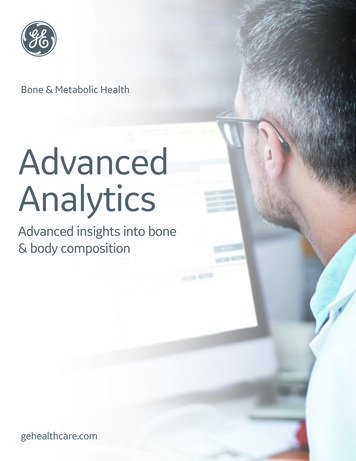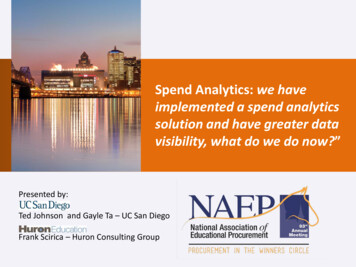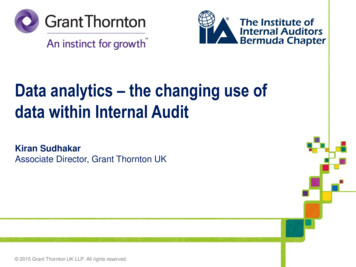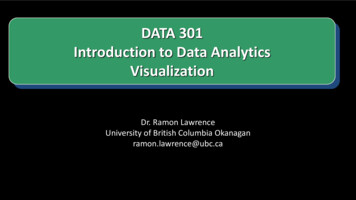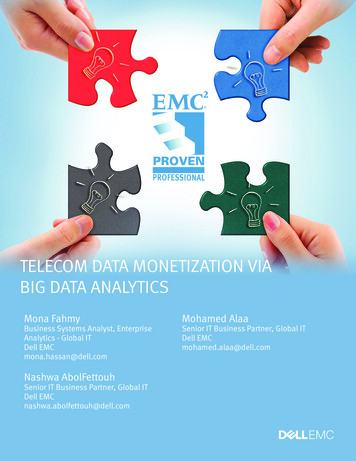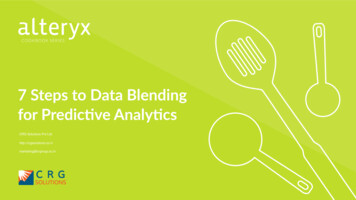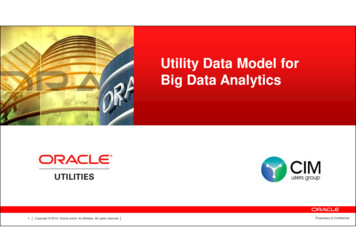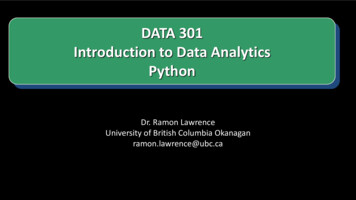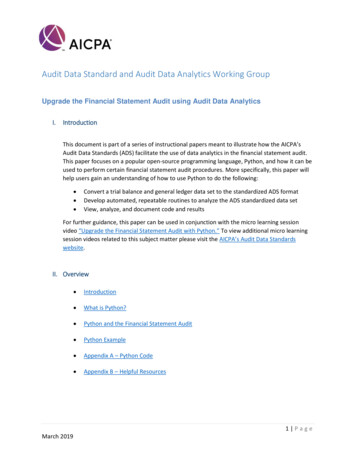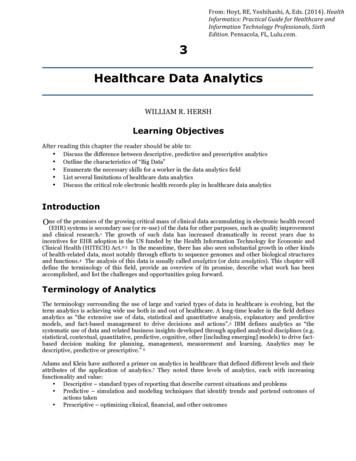
Transcription
3From:Hoyt,RE,Y onals,SixthEdition.P ensacola,FL,Lulu.com.Healthcare Data AnalyticsWILLIAM R. HERSHLearning ableto: Discuss the difference between descriptive, predictive and prescriptive analytics Outline the characteristics of “Big Data” Enumerate the necessary skills for a worker in the data analytics field List several limitations of healthcare data analytics Discuss the critical role electronic health records play in healthcare data analyticsIntroductionOne of the promises of the growing critical mass of clinical data accumulating in electronic health record(EHR) systems is secondary use (or re-use) of the data for other purposes, such as quality improvementand clinical research.1 The growth of such data has increased dramatically in recent years due toincentives for EHR adoption in the US funded by the Health Information Technology for Economic andClinical Health (HITECH) Act.2-3 In the meantime, there has also seen substantial growth in other kindsof health-related data, most notably through efforts to sequence genomes and other biological structuresand functions.4 The analysis of this data is usually called analytics (or data analytics). This chapter willdefine the terminology of this field, provide an overview of its promise, describe what work has beenaccomplished, and list the challenges and opportunities going forward.Terminology of AnalyticsThe terminology surrounding the use of large and varied types of data in healthcare is evolving, but theterm analytics is achieving wide use both in and out of healthcare. A long-time leader in the field definesanalytics as “the extensive use of data, statistical and quantitative analysis, explanatory and predictivemodels, and fact-based management to drive decisions and actions”.5 IBM defines analytics as “thesystematic use of data and related business insights developed through applied analytical disciplines (e.g.statistical, contextual, quantitative, predictive, cognitive, other [including emerging] models) to drive factbased decision making for planning, management, measurement and learning. Analytics may bedescriptive, predictive or prescriptive.” 6Adams and Klein have authored a primer on analytics in healthcare that defined different levels and theirattributes of the application of analytics.7 They noted three levels of analytics, each with increasingfunctionality and value: Descriptive – standard types of reporting that describe current situations and problems Predictive – simulation and modeling techniques that identify trends and portend outcomes ofactions taken Prescriptive – optimizing clinical, financial, and other outcomes
Much work is focusing now on predictive analytics, especially in clinical settings attempting to optimizehealth and financial outcomes.There are a number of terms related to data analytics. A core methodology in data analytics is machinelearning, which is the area of computer science that aims to build systems and algorithms that learn fromdata.8 One of the major techniques of machine learning is data mining, which is defined as the processingand modeling of large amounts of data to discover previously unknown patterns or relationships.9 Asubarea of data mining is text mining, which applies data mining techniques to mostly unstructuredtextual data.10 Another close but more recent term in the vernacular is big data, which describes large andever-increasing volumes of data that adhere to the following attributes:11 Volume – ever-increasing amounts Velocity – quickly generated Variety – many different types Veracity – from trustable sourcesWith the digitization of clinical data, hospitals and other healthcare organizations are generating an everincreasing amount of data. In all healthcare organizations, clinical data takes a variety of forms, fromstructured (e.g., images, lab results, etc.) to unstructured (e.g., textual notes including clinical narratives,reports, and other types of documents). For example, it is estimated by Kaiser-Permanente that its currentdata store for its 9 million members exceeds 30 petabytes of data.12 Other organizations are planning fora data-intensive future. Another example is the American Society for Clinical Oncology (ASCO) that isdeveloping its Cancer Learning Intelligence Network for Quality (CancerLinQ).13 CancerLinQ will providea comprehensive system for clinicians and researchers consisting of EHR data collection, application ofclinical decision support, data mining and visualization, and quality feedback.Another source of large amounts of data is the world’s growing base of scientific literature and itsunderlying data that is increasingly published in journals and other articles (see Chapter on onlinemedical resources). One approach to this problem that has generated attention is the IBM Watson project,which started as a generic question-answering system that was made famous by winning at the TV gameshow Jeopardy!14 IBM has since focused Watson in the healthcare domain.15Kumar et al. have noted that the process of big data analytics resembles a pipeline, and have developed anapproach that specifies four major steps in this pipeline, to which we can place data sources and actionson it pertinent to healthcare and biomedicine.16 The pipeline begins with input data sources, which inhealthcare and biomedicine may include clinical records, financial records, genomics and related data,and other types, even those from outside the healthcare setting (e.g., census data). The next step is featureextraction, where various computational techniques are used to organize and extract elements of the data,such as linking records across sources, using natural language processing (NLP) to extract and normalizeconcepts, and matching of other patterns. This is followed by statistical processing, where machinelearning and related statistical inference techniques are used to make conclusions from the data. The finalstep is the output of predictions, often with probabilistic measures of confidence in the results. (figure 3.1)The growing quantity of data requires that its users have a good understanding of its provenance, which iswhere the data originated and how trustworthy it is for large-scale processing and analysis.17 A number ofresearchers and thought leaders have started to specify the path that will be required for big data to beapplied in healthcare and biomedicine.18-20 An edited volume was recently published about analyticsapplied in various aspects healthcare and life sciences.21A more peripheral but related term is business intelligence, which in healthcare refers to the “processesand technologies used to obtain timely, valuable insights into business and clinical data”.7 Anotherrelevant term is the notion promoted by the Institute of Medicine of the learning health system.22-23Advocates of this approach note that routinely collected data can be used for continuous learning to allowthe healthcare system to better carry out disease surveillance and response, targeting of healthcareservices, improving decision-making, managing misinformation, reducing harm, avoiding costly errors,and advancing clinical research.24
Figure 3.1 The Analytics(Adapted from Kumar)16PipelineAnother set of related terms come from the call for new and much more data-intensive approaches todiagnosis and treatment of disease variably called personalized medicine,25 precision medicine,26 orcomputational medicine.27 Advocates for these approaches note the inherent complexity of nonlinearsystems in biomedicine, with large amounts and varied types of data that will need models to enable theirpredictive value. Technology thought leader O’Reilly notes that data science is transforming medicine,striving to solve its equivalent of the “Wanamaker Dilemma” for advertisers, named after the problem ofknowing that half of advertising by merchants does not work, but that the half that does not work is notknown.28One of the major motivators for data analytics comes from new models of healthcare delivery, such asaccountable care organizations (ACOs), where reimbursement for conditions and episodes is bundled ina variety of ways, providing incentive move to deliver high-quality care in cost-efficient ways.29 ACOsrequire a focused IT infrastructure that provides data that can be used to predict and quickly act on excesscosts.30 One of the challenges for healthcare data is that patients often get their care and testing indifferent settings (e.g., a patient seen in a physician office, sent to a free-standing laboratory or radiologycenter, and also seen in the offices of specialists or being hospitalized. This has increased the need fordevelopment of health information exchange (HIE), where data is shared among entities caring for apatient across business boundaries.31 A well-known informatics blogger has succinctly noted that “ACO HIE analytics”.32Challenges to Data AnalyticsThere are, of course, challenges to data analytics. One concern is that data generated in the routine care ofpatients may be limited in its use for analytical purposes.33 For example, such data may be inaccurate orincomplete. It may be transformed in ways that undermine its meaning (e.g., coding for billing priorities).It may exhibit the well-known statistical phenomenon of censoring, i.e., the first instance of disease inrecord may not be when it was first manifested (left censoring) or the data source may not cover asufficiently long time interval (right censoring). Data may also incompletely adhere to well-knownstandards, which makes combining it from different sources more difficult. Finally, clinical data mostly
only allows observational and not experimental studies, thus raising issues of cause-and-effect of findingsdiscovered.Others have noted larger challenges around analytics and big data. Boyd and Crawford have expressedsome “provocations” for the growing use of data-driven research.34 They note that research questionsasked of the data tend to be driven by what can be answered, as opposed to prospective hypotheses. Theyalso note that data are not always as objective as we might like, and that “bigger” is not necessarily better.Finally, they raise ethical concerns over how the data of individuals is used, the means by which it iscollected, and the possible divide between those who have access to data and those who do not. Similarconcerns focused specifically on healthcare data by Neff, who describes a myriad of technical, financial,and ethical issues that must be addressed before we will be able to make use of big data routinely forclinical practice and other health-related purposes.35 These challenges also create ethical issues, such aswho owns data and who has privileges to use it.36Research and Application of AnalyticsThe research base around applying analytics to improve healthcare delivery is still in its early stages.There is an emerging base of research that demonstrates how data from operational clinical systems canbe used to identify critical situations or patients whose costs are outliers. There is less research, however,demonstrating how this data can be put to use to actually improve clinical outcomes or reduce costs.Studies using EHR data for clinical prediction have been proliferating. One common area of focus hasbeen the use of data analytics to identify patients at risk for hospital readmission within 30 days ofdischarge. The importance of this factor comes from the US Centers for Medicare and Medicaid Services(CMS) Readmissions Reduction Program that penalizes hospitals for excessive numbers of readmissions.37 This has led several researchers to assess EHR data in its value to predict patients at risk forreadmission.38-40A number of other critical clinical situations have been amenable to detection by analytics applied to EHRand other clinical data: Predicting 30-day risk of readmission and death among HIV-infected inpatients 41 Identification of children with asthma42 Risk-adjusting hospital mortality rates 43 Detecting postoperative complications 44 Measuring processes of care 45 Determining five-year life expectancy 46 Detecting potential delays in cancer diagnosis 47 Identifying patients with cirrhosis at high risk for readmission 48 Predicting out of intensive care unit cardiopulmonary arrest or death 49Additional efforts have focused on helping to identify patients for participation in research protocols orimprove diagnosis of disease: Identifying patients who might be eligible for participation in clinical studies 50 Determining eligibility for clinical trials 51 Identifying patients with diabetes and the earliest date of diagnosis 52 Predicting diagnosis in new patients 53Other researchers have also been able to use EHR data to replicate the results of randomized controlledtrials (RCTs). One large-scale effort has come from the Health Maintenance Organization ResearchNetwork’s Virtual Data Warehouse (VDW) Project.54 Using the VDW, for example, researchers were ableto demonstrate a link between childhood obesity and hyperglycemia in pregnancy.55 Anotherdemonstration of this ability has come from United Kingdom General Practice Research Database(UKGPRD), a repository of longitudinal records of general practitioners. Using this data, Tannen et al.were able to demonstrate the ability to replicate the findings of the Women’s Health Initiative 56-57 andRCTs of other cardiovascular diseases. 58-59 Likewise, Danaei et al. were able to combine subject-matter
expertise, complete data, and statistical methods emulating clinical trials to replicate RCTs demonstratingthe value of statin drugs in primary prevention of coronary heart disease.60These large repositories have been used for other research purposes. For example, the UKGPRD has beenused for determining risk factors for pancreatic c
show Jeopardy!14 15IBM has since focused Watson in the healthcare domain. Kumar et al. have noted that the process of big data analytics resembles a pipeline, and have developed an approach that specifies four major steps in this pipeline, to which we can place data sources and actions on it pertinent to healthcare and biomedicine.16 The pipeline begins with input data sources, which in .

